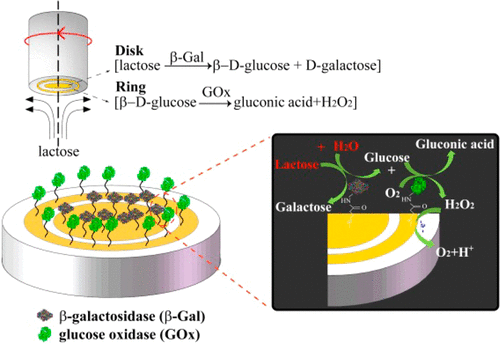当前位置:
X-MOL 学术
›
Anal. Chem.
›
论文详情
Our official English website, www.x-mol.net, welcomes your feedback! (Note: you will need to create a separate account there.)
Illustrating the Mass-Transport Effect on Enzyme Cascade Reaction Kinetics by Use of a Rotating Ring–Disk Electrode
Analytical Chemistry ( IF 7.4 ) Pub Date : 2017-11-15 00:00:00 , DOI: 10.1021/acs.analchem.7b03780 Zeng-Qiang Wu 1 , Jun-Jun Liu 1 , Jin-Yi Li 1 , Dan Xu 1 , Xing-Hua Xia 1
Analytical Chemistry ( IF 7.4 ) Pub Date : 2017-11-15 00:00:00 , DOI: 10.1021/acs.analchem.7b03780 Zeng-Qiang Wu 1 , Jun-Jun Liu 1 , Jin-Yi Li 1 , Dan Xu 1 , Xing-Hua Xia 1
Affiliation

|
Electrochemical biosensors based on enzymatic reaction have been applied to a wide range of fields. As the trend continues to grow, these biosensors are approaching the limit imposed by physics and chemistry. To further improve the performance of biosensors, the interplay of mass transport and enzymatic reaction kinetics, especially in enzyme cascade systems, should be considered in the design of biosensors. Herein, we propose a simple approach to studying the influence of mass transport and enzyme molecule motion on the kinetics of enzyme cascade reactions. β-Galactosidase (β-Gal) and glucose oxidase (GOx) of the enzyme cascade reaction are precisely immobilized onto the disk and ring electrodes, respectively, of a rotating ring–disk electrode (RRDE) via covalent attachment. At a low rotating speed (<600 rpm), convective transport promotes the enzyme cascade reaction. When the rotating speed is higher than 600 rpm, the cascade reaction becomes kinetically controlled. Further increase of the rotating speed results in a slow decline in reaction rate, possibly due to the production inhibition effect. In addition, the effect of conformation change of the enzyme at higher centrifugal forces on enzyme activity should be considered. This study would shine light on the effect of convective force on regulation of kinetics of enzyme cascade reaction, offering an ideal platform for studying other enzyme cascade reactions and providing fundamentals to design high-performance biosensors, biofuel cells, and bioelectronics.
中文翻译:

通过使用旋转的圆盘电极说明质量转移对酶级联反应动力学的影响
基于酶促反应的电化学生物传感器已被广泛应用于各个领域。随着趋势的继续发展,这些生物传感器正在接近物理和化学施加的极限。为了进一步改善生物传感器的性能,在生物传感器的设计中应考虑质量传递和酶促反应动力学的相互作用,尤其是在酶级联系统中。在这里,我们提出了一种简单的方法来研究质量运输和酶分子运动对酶级联反应动力学的影响。酶级联反应的β-半乳糖苷酶(β-Gal)和葡萄糖氧化酶(GOx)通过共价连接分别精确地固定在旋转环-圆盘电极(RRDE)的圆盘和圆环电极上。在低转速(<600 rpm)下,对流运输促进了酶的级联反应。当转速高于600rpm时,级联反应变为动力学控制的。旋转速度的进一步增加导致反应速率的缓慢下降,这可能是由于产生抑制作用所致。另外,应当考虑在更高的离心力下酶的构象变化对酶活性的影响。该研究将揭示对流对酶级联反应动力学调节的影响,为研究其他酶级联反应提供理想的平台,并为设计高性能生物传感器,生物燃料电池和生物电子学提供基础。旋转速度的进一步增加导致反应速率的缓慢下降,这可能是由于产生抑制作用所致。另外,应当考虑在更高的离心力下酶的构象变化对酶活性的影响。该研究将揭示对流对酶级联反应动力学调节的影响,为研究其他酶级联反应提供理想的平台,并为设计高性能生物传感器,生物燃料电池和生物电子学提供基础。旋转速度的进一步提高可能是由于产生抑制作用而导致反应速率的缓慢降低。另外,应当考虑在更高的离心力下酶的构象变化对酶活性的影响。该研究将揭示对流对酶级联反应动力学调节的影响,为研究其他酶级联反应提供理想的平台,并为设计高性能生物传感器,生物燃料电池和生物电子学提供基础。
更新日期:2017-11-16
中文翻译:

通过使用旋转的圆盘电极说明质量转移对酶级联反应动力学的影响
基于酶促反应的电化学生物传感器已被广泛应用于各个领域。随着趋势的继续发展,这些生物传感器正在接近物理和化学施加的极限。为了进一步改善生物传感器的性能,在生物传感器的设计中应考虑质量传递和酶促反应动力学的相互作用,尤其是在酶级联系统中。在这里,我们提出了一种简单的方法来研究质量运输和酶分子运动对酶级联反应动力学的影响。酶级联反应的β-半乳糖苷酶(β-Gal)和葡萄糖氧化酶(GOx)通过共价连接分别精确地固定在旋转环-圆盘电极(RRDE)的圆盘和圆环电极上。在低转速(<600 rpm)下,对流运输促进了酶的级联反应。当转速高于600rpm时,级联反应变为动力学控制的。旋转速度的进一步增加导致反应速率的缓慢下降,这可能是由于产生抑制作用所致。另外,应当考虑在更高的离心力下酶的构象变化对酶活性的影响。该研究将揭示对流对酶级联反应动力学调节的影响,为研究其他酶级联反应提供理想的平台,并为设计高性能生物传感器,生物燃料电池和生物电子学提供基础。旋转速度的进一步增加导致反应速率的缓慢下降,这可能是由于产生抑制作用所致。另外,应当考虑在更高的离心力下酶的构象变化对酶活性的影响。该研究将揭示对流对酶级联反应动力学调节的影响,为研究其他酶级联反应提供理想的平台,并为设计高性能生物传感器,生物燃料电池和生物电子学提供基础。旋转速度的进一步提高可能是由于产生抑制作用而导致反应速率的缓慢降低。另外,应当考虑在更高的离心力下酶的构象变化对酶活性的影响。该研究将揭示对流对酶级联反应动力学调节的影响,为研究其他酶级联反应提供理想的平台,并为设计高性能生物传感器,生物燃料电池和生物电子学提供基础。


























 京公网安备 11010802027423号
京公网安备 11010802027423号